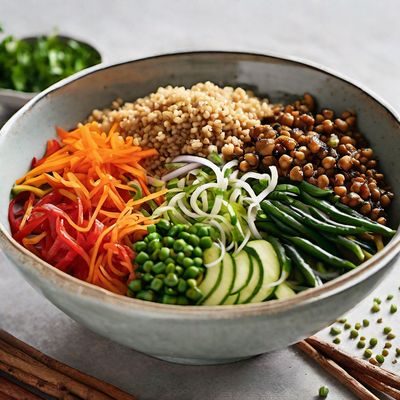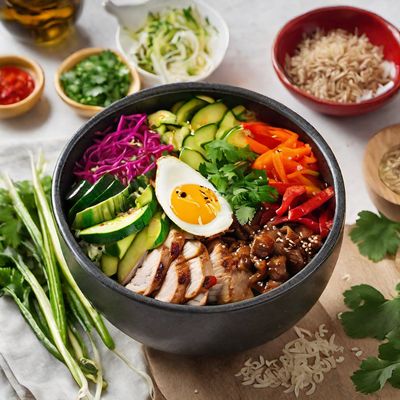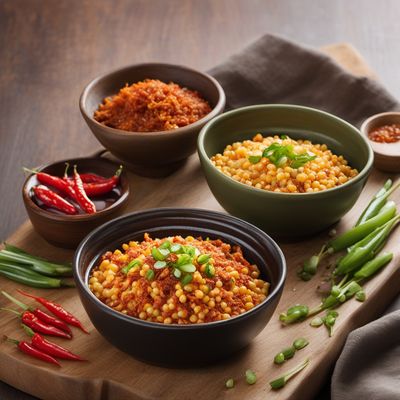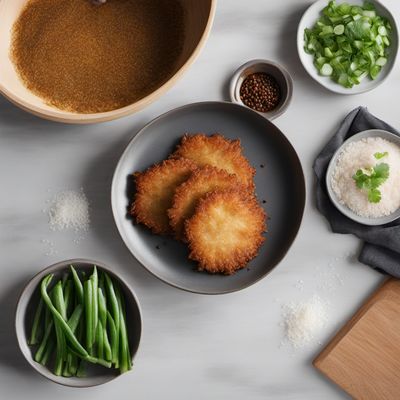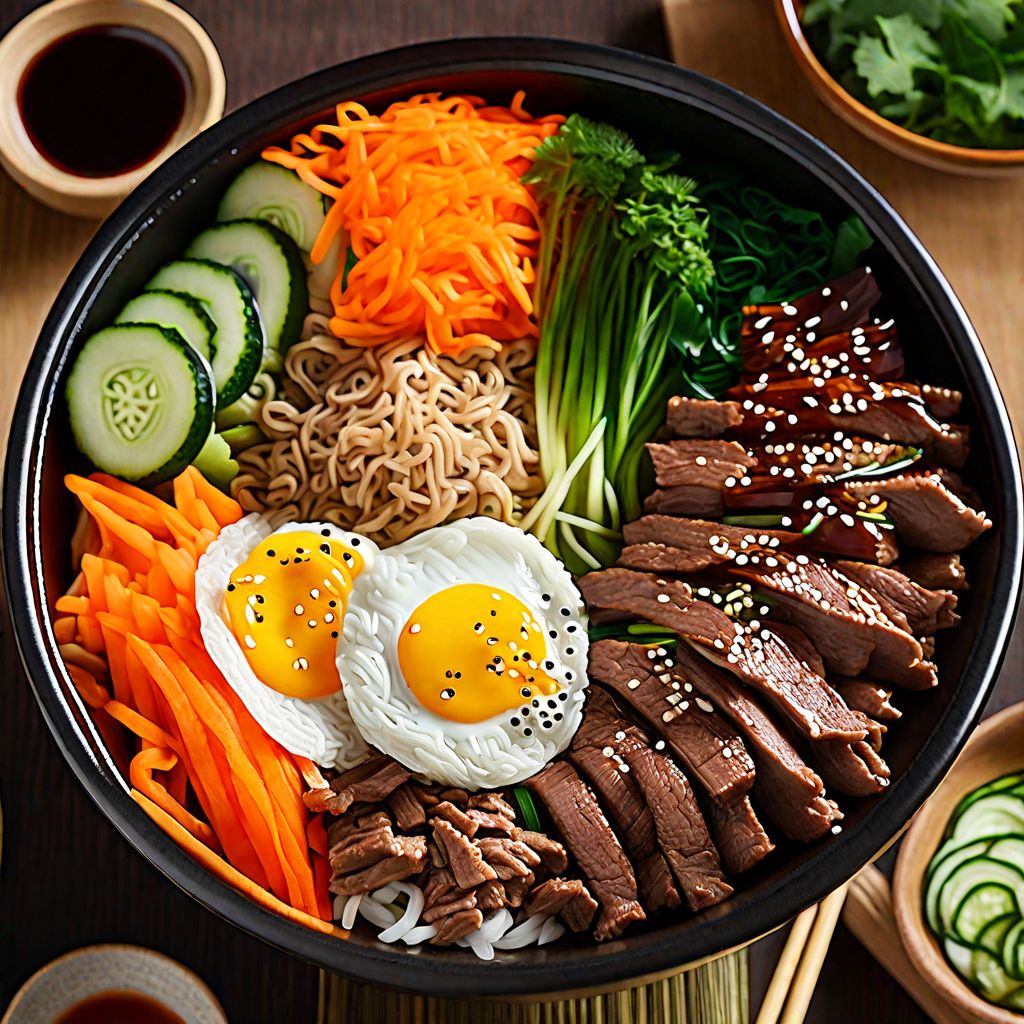
Recipe
Taiwanese-style Bibimbap
Taiwanese Fusion Bibimbap: A Delicious Twist on a Korean Classic
4.9 out of 5
In Taiwanese cuisine, flavors are vibrant and ingredients are fresh. This Taiwanese-style Bibimbap takes inspiration from the Korean original and infuses it with the unique tastes of Taiwan. With a medley of colorful vegetables, marinated meat, and a flavorful sauce, this dish is a delightful fusion of two culinary worlds.
Metadata
Preparation time
20 minutes
Cooking time
15 minutes
Total time
35 minutes
Yields
4 servings
Preparation difficulty
Easy
Suitable for
Vegetarian, Gluten-free, Dairy-free, Nut-free, Low-fat
Allergens
Soy, Sesame
Not suitable for
Vegan, Paleo, Keto, High-protein, Low-carb
Ingredients
While the Korean Bibimbap traditionally uses gochujang sauce, this Taiwanese adaptation incorporates a tangy and slightly sweet sauce made with soy sauce, rice vinegar, and a hint of sesame oil. Additionally, Taiwanese Bibimbap often includes ingredients like pickled daikon radish and marinated tofu, giving it a distinct flavor profile. We alse have the original recipe for Bibimbap, so you can check it out.
-
2 cups (470ml) cooked short-grain rice 2 cups (470ml) cooked short-grain rice
-
200g (7oz) beef, thinly sliced 200g (7oz) beef, thinly sliced
-
1 tablespoon vegetable oil 1 tablespoon vegetable oil
-
1 cup (150g) julienned carrots 1 cup (150g) julienned carrots
-
1 cup (150g) julienned cucumber 1 cup (150g) julienned cucumber
-
1 cup (150g) bean sprouts 1 cup (150g) bean sprouts
-
1 cup (150g) sliced mushrooms 1 cup (150g) sliced mushrooms
-
1 cup (150g) pickled daikon radish 1 cup (150g) pickled daikon radish
-
1 cup (150g) marinated tofu, cubed 1 cup (150g) marinated tofu, cubed
-
4 eggs 4 eggs
-
Sesame seeds, for garnish Sesame seeds, for garnish
-
For the sauce: For the sauce:
-
3 tablespoons soy sauce 3 tablespoons soy sauce
-
2 tablespoons rice vinegar 2 tablespoons rice vinegar
-
1 tablespoon sesame oil 1 tablespoon sesame oil
-
1 tablespoon honey 1 tablespoon honey
-
1 garlic clove, minced 1 garlic clove, minced
Nutrition
- Calories (kcal / KJ): 450 kcal / 1884 KJ
- Fat (total, saturated): 12g, 3g
- Carbohydrates (total, sugars): 65g, 8g
- Protein: 22g
- Fiber: 6g
- Salt: 2g
Preparation
-
1.In a small bowl, whisk together the soy sauce, rice vinegar, sesame oil, honey, and minced garlic to make the sauce. Set aside.
-
2.Heat the vegetable oil in a skillet over medium heat. Add the beef slices and cook until browned. Remove from heat and set aside.
-
3.In the same skillet, sauté the carrots, cucumber, bean sprouts, and mushrooms until tender-crisp.
-
4.In a separate pan, fry the eggs sunny-side up or to your preference.
-
5.Divide the cooked rice among four bowls. Arrange the cooked vegetables, beef, pickled daikon radish, marinated tofu, and fried eggs on top of the rice.
-
6.Drizzle the sauce over the ingredients in each bowl and sprinkle with sesame seeds for garnish.
Treat your ingredients with care...
- Beef — For a tender and flavorful result, marinate the beef in soy sauce, garlic, and ginger for at least 30 minutes before cooking.
- Marinated tofu — Pat the tofu dry before marinating it in a mixture of soy sauce, sesame oil, and a pinch of sugar. Let it marinate for at least 1 hour for maximum flavor absorption.
- Pickled daikon radish — If you can't find pickled daikon radish, you can substitute it with pickled cucumber or pickled carrots for a similar tangy crunch.
- Bean sprouts — Blanch the bean sprouts in boiling water for a minute, then immediately transfer them to an ice bath to retain their crispness.
Tips & Tricks
- To add an extra kick of flavor, sprinkle some Taiwanese chili flakes or chili oil on top of the Bibimbap.
- Feel free to customize your Taiwanese-style Bibimbap by adding other vegetables such as blanched spinach, sliced bell peppers, or shredded cabbage.
- For a vegetarian version, omit the beef and double the amount of marinated tofu or add sautéed shiitake mushrooms for a meaty texture.
- If you prefer a runny yolk, cook the eggs over easy instead of sunny-side up.
- Leftover Bibimbap can be stored in the refrigerator for up to 2 days. Reheat it in a skillet or microwave before serving.
Serving advice
Serve the Taiwanese-style Bibimbap hot, allowing each person to mix the ingredients together before enjoying. The combination of flavors and textures is best experienced when everything is well combined.
Presentation advice
For an appealing presentation, arrange the colorful vegetables, beef, and tofu in separate sections on top of the rice. Place the fried egg in the center and sprinkle sesame seeds over the entire dish. The vibrant colors and contrasting textures will make your Taiwanese-style Bibimbap visually enticing.
More recipes...
For Bibimbap » Browse all
For Korean cuisine » Browse all
More Korean cuisine dishes » Browse all

Sannakji
Live Octopus
Sannakji is a traditional Korean dish that consists of live octopus that is cut into small pieces and served raw. It is a unique and adventurous...
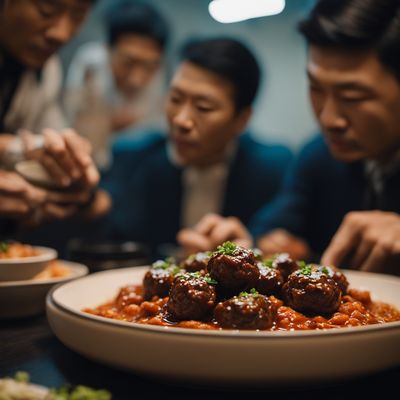
Wanja jorim
Korean meatballs with soy sauce
Wanja jorim is a Korean braised beef dish that is flavored with soy sauce, garlic, and ginger.
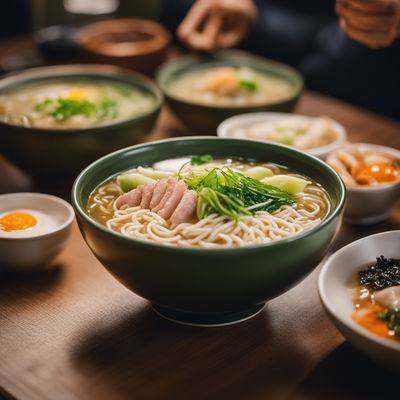
Onmyeon
Cold noodle soup
Onmyeon is a Korean cold noodle dish that is perfect for hot summer days. The dish is made with thin, chewy noodles made from wheat flour, potato...
More Taiwanese cuisine dishes » Browse all

Beef Noodle Soup
Beef noodle soup is a hearty and comforting dish that is popular in many Asian countries. It typically consists of tender beef, chewy noodles, and...
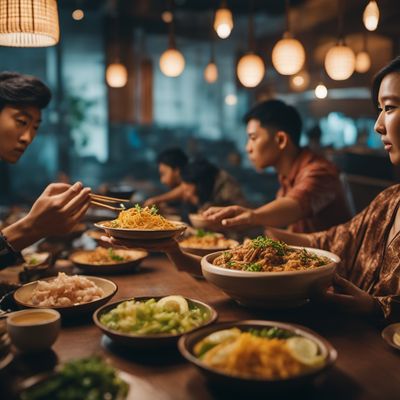
Aiyùbīng
Aiyubing
Aiyùbīng is a traditional Taiwanese dessert made from aiyu jelly and fruit. It is a refreshing and healthy dessert that is often served during the...

Oil-Soaked Chicken
Oil-Soaked Chicken is a popular Chinese dish that is loved by many. It is a simple yet delicious dish that is perfect for any occasion.
